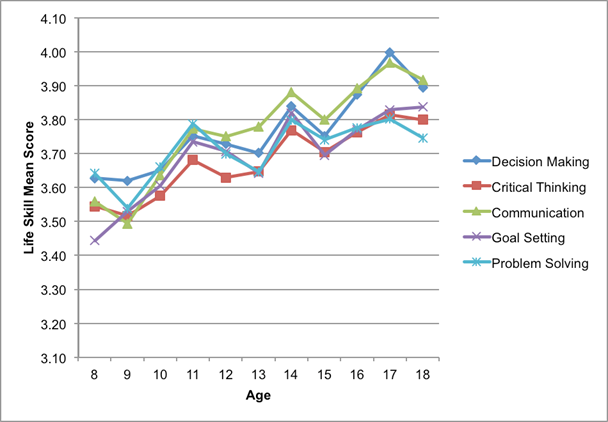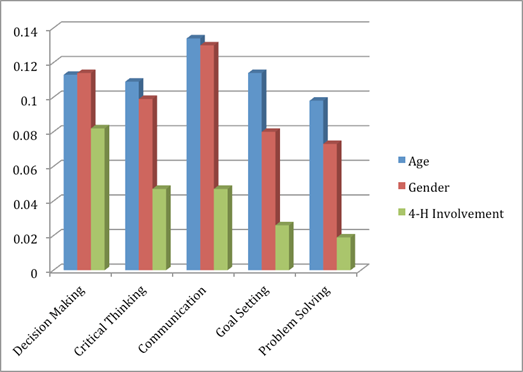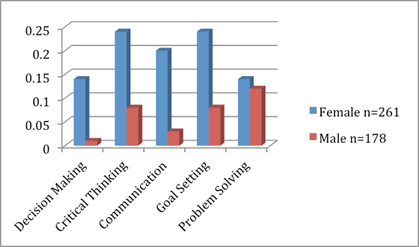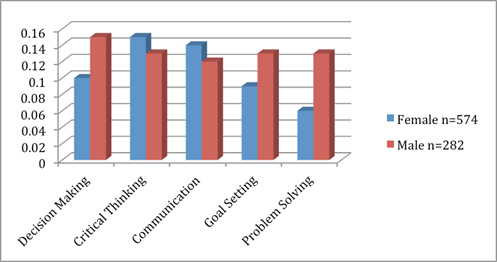 |
June 2015
|
June 2015 // Volume 53 // Number 3 // Feature // v53-3a8
The Effects of Age, Gender, and 4-H Involvement on Life Skill Development
Abstract
The study reported here examined the effects of age, gender, and 4-H involvement in clubs on life skill development of youth ages eight to 18 over a 12-month period. Regression analyses found age, gender, and 4-H involvement significantly influenced life skill development. Results found that females have higher levels of competencies in life skills at the start of the program and were more likely to change in these areas during the year than their male counterparts. This suggests changes in program designs may be needed to better engage, retain, and affect males in life skill development.
Introduction
For more than one hundred years, the 4-H Youth Development program has supported the healthy development of young people. According to the 2012 National 4-H Enrollment Report (USDA/NIFA, 2012), almost six million youth aged eight to 18 participated in a variety of clubs, camps, and other activities during their out-of-school time. 4-H curricula and activities are designed to foster life skill development and support positive personal and social skill development. Most 4-H programming and curriculum content are based on sound research and provide hands-on activities in the program areas of citizenship, healthy living, and science that are 4-H's identified mission mandates (National 4-H Headquarters, 2011). 4-H Youth Development programs supply opportunities for youth to: (1) engage in learning activities and events that foster their skills and competencies; (2) build positive relationships with caring adults; (3) contribute to their communities; and (4) have multi-cultural experiences. The 4-H Youth Development program uses structured activities as a strategy for developing critical life skills, fostering citizenship, and promoting leadership.
These programs occur during out-of-school hours at times that include before and after school, evenings, weekends, and summer. If designed appropriately, youth programs offer a safe environment that provides opportunities for youth to explore their world, develop life skills, and gain a sense of belonging with peers and adults as well as within themselves.
Nevertheless, like many other youth-serving organizations, 4-H is challenged to provide outcome data that assist in garnering support and future funding from governmental agencies, foundations, and donors. The current push for evidence-based programs has increased the importance for 4-H to provide empirical evidence related to programs that work. In addition, more research is needed to better understand factors that may also affect life skills, such as age, gender, and predisposition (level of life skill competencies at the start of the program). Finally, more research is needed to better understand how to assess life skills in order to use the information to improve program design and impact. The study reported in this article begins to address these gaps and contributes additional insights into measuring the development of life skills among youth involved in the 4-H program.
Does 4-H Contribute to Skill Development, and Do Age and Gender Matter?
In examining the effect of age and gender on skill development, Bartoszuk and Randall (2011) found age and gender of 4-H participants significantly influenced skill building (p <.05 and p <.01 respectively), with older youth and females scoring higher. The results suggested satisfaction with 4-H experiences related to the level of skill building. Authors recommended ensuring young adolescents are building skills in areas that are personally meaningful to them. The article did not examine the effect of 4-H involvement on skill development.
The Tufts Study of Positive Youth Development (Lerner et al., 2005), a landmark longitudinal study, examined the impact that out-of-school time programs had on personal and social skills as youth develop. The results suggested that participation in high-quality, structured, out-of-school-time programs such as 4-H—when combined with sustained adult interaction and mentoring—benefit both the youth and their communities. These youth are more likely to exhibit positive behaviors and less likely to engage in risk-taking behaviors, such as underage drinking, tobacco use, and bullying.
In addition, Eccles, Barber, Stone and Hunt (2003) suggest that there is evidence that involvement in constructive, out-of-school-time programs like 4-H supports continued school engagement, academic achievement, and other aspects of positive development during the teen and early adult years. They note that more research is needed about the extent of the effects, the characteristics of the youth who decide to participate, and how their personal characteristics interact with program components.
Hamilton, Northern, and Neff (2014) suggest in their article that age, gender, race/ethnicity, and years of 4-H involvement may influence drop-out rates for 4-H youth involved in clubs. Their reported results found girls were more likely to join clubs and boys who did join were more likely to drop-out, especially for older youth. The authors suggestions include: paying more attention to new recruits with such things as matching or a buddy system; retaining older members through adapting to their changing needs and interests, and providing opportunities for leadership; and recruiting more diverse volunteers, especially Black and Hispanic men.
Measuring Life Skills
In the 4-H Youth Development program, educational activities and curricula center on projects that are used to teach youth content knowledge in a broad range of areas. Moreover, the 4-H Youth Development program focuses on the application of that knowledge and the promotion of life skills. Common life skills across most of the curricula used in 4-H programming are those needed to make decisions, solve problems, communicate effectively, think critically, and set goals. When designing programs for youth, it is important to understand how youth develop and identify those life skills that contribute to their healthy development. Life skills comprise the majority of competencies within the personal and social assets categories identified in the National Research Council and Institute of Medicine's, Community Programs to Support Youth Development (Eccles & Gootman 2002). According to Eccles and Gootman (2002), youth need opportunities and support from their communities to develop these important personal and social assets to become competent, contributing adult members of society. Programs designed to support young people with positive experiences, environments, and people support young people in the acquisition of these skills (Perkins, Borden, Keith, Hoppe, Rooney, & Villarruel, 2003).
Through curricula, program activities, and positive relationships between adults and youth, 4-H and other youth development programs provide the opportunities to gain and refine life skills that comprise personal or social assets. This need for structured environments to help guide children's development has been a major focus of public attention, policy, and research over the last decade (Roth & Brooks-Gunn 2003; Eccles & Gootman 2002; Tolman & Pittman 2002). Programs that can document effectiveness are needed within the youth development field.
The purpose of the study reported here was to examine if the level of participation in 4-H affects life skill development over time. In addition, research questions were examined using data from the study to better understand how other factors (i.e., age, gender, and predisposition) may affect life skill development and reported in this article.
Methodology
Participants
Almost 6,000 (5,946) 4-H youth participated in clubs from Pennsylvania who completed pre-surveys between 2003 and 2013. Post-surveys were collected 1 year after the pre-surveys for approximately 32% of the youth (1,901) in order to assess changes in life skill development over time.
Instrument
The life skill instrument used was developed by Perkins and Mincemoyer (2005). The Every Day Living Life Skills has 26 items and was used to assess decision making, critical thinking, communication, goal setting, and problem solving (instrument available at: http://www.humanserviceresearch.com/youthlifeskillsevaluation/every.pdf). The survey also collected information on age, gender, and years of involvement in 4-H.
Analyses
First, Exploratory Factor Analysis was run to assess if there were multiple constructs (decision making, problem solving, goal setting, critical thinking, and communication) as theorized using the 5,946 (pre-surveys) and 1,901 (post-surveys) data sets. A Generalized Least Squares extraction with a promax rotation was used because of previous results suggesting the items and constructs are correlated. The results of the factor analyses using both pre- and post-survey data highly suggest multiple constructs or life skills within the Skills for Every Day Living instrument. Generally, decision making, critical thinking, and communication stood alone, while problem solving and goal setting seemed to group together. For the purpose of this article, the five theoretical constructs were calculated and used as the basis for the dependent variables in the following analyses. A total score was also used as one of the dependent variables to show differences between males and females across the ages (8 to 18 years old).
Second, reliabilities were completed on the items for the five theorized constructs using the 5,946 data set for pre-surveys and 1,901 on post-surveys. Reliabilities of the five theoretical constructs on the pre-surveys were high for both pre- and post- constructs: decision making (alpha = .76; .78); Critical Thinking (alpha = .75; .73); communication (alpha = .79; .78); goal setting (alpha = .82; .81); and problem solving (alpha = .86; .85).
Third, a set of step-wise regressions were run on the 5,946 data set on all five pre- constructs to determine the relationship between the life skill constructs and age, gender, and 4-H involvement at the time of the pre-survey. Mean life skill scores were also calculated for displaying figures and the relationships between the independent variables. In addition, two groups were created based on less than 3 years of 4-H involvement and 3 or more years involvement in 4-H for displaying the relationship between the life skills.
Fourth, a set of analyses involving a sub-set of 1,901 with matching pre- and post-surveys was used to create change scores (post- minus pre- scores) of the constructs as the dependent variables in step-wise regressions. Independent variables consisted of pre-survey scores (controlling for age and level of life skills at the time of the pre-survey), gender, and years of 4-H involvement.
Results
Age
The largest age group was 12 years, with a range from eight to 18 years (means = 12.74 and 12.5). No significant differences were found between the two data sets on age. Results (Figure 1) show that life skills increase with age. One surprising result is that in 10 years, the mean shifts for each of the life skills were less than .5 on a scale of one to five. Age was significantly related to all five life skills (Table 1)
Figure 1.
Mean Distribution of Pre-Life Skills by Age (N=5,946)
Gender
Approximately two-thirds (64.7% and 61%) of the youth were female, with no significant differences found between the two data sets. Results (Figure 2) found females were significantly higher in the five life skill areas at the start of the program (Table 1) and changed significantly more during the year than males (Table 2).
Figure 2.
Distribution of Pre-Life Skill Mean Scores by Gender (N=5,946)

Gender differences were also consistent across the age groups (Figure 3).
Figure 3.
Distribution of Total Pre-Life Skill Mean Score by Gender and Age (N=5,946)
Years of 4-H Involvement
Years of 4-H involvement at the time of pre-survey ranged from zero to 10 years, with an average of 2.7 years for both data sets taken at the time of the pre-survey. No significant differences were found between the data sets on 4-H involvement. Years of 4-H involvement highly correlated with age in both data sets (r=.674 and .70), which is one of the primary reasons why pre-surveys were used both as independent variables in the regressions assessing change and dependent variables when assessing all three primary independent variables together (i.e., age, gender, and 4-H Involvement). For purposes of visualizing 4-H involvement across the life skill constructs, two groups were created (youth with under 3 years of involvement and youth with t3 or more years of involvement (Figure 4). Results of One Way ANOVA'S comparing these two groups found 4-H involvement significantly affected all five life skills (p < .000).
Figure 4.
Distribution of Pre-Life Skill Mean Scores by 4-H Involvement (N=5,946)
Effects of Age, Gender, and 4-H Involvement on Pre-Survey Scores
Because youth started the programs at varying ages with varying 4-H involvement, a series of regressions were run on the life skills pre-survey scores to assess relationships between age, gender, and 4-H involvement. In this model, age and gender significantly related to all five life skill constructs, with older youth and females scoring higher (Table 1). 4-H involvement significantly related to three of the life skills (decision making, critical thinking, and communication).
| Decision Making | B | SE B | β | |
| (Constant) | 2.141 | 0.08 | ||
| Age | -0.565 | 0.02 | 0.113*** | |
| Gender | -0.119 | 0.029 | 0.114*** | |
| 4-H Involvement | 0.023 | 0.006 | .082** | |
| R2 | 0.035 | |||
| Critical Thinking | B | SE B | β | |
| (Constant) | 3.332 | .048 | ||
| Age | .027 | .004 | 0.109*** | |
| Gender | -.140 | .019 | 0.099*** | |
| 4-H Involvement | .012 | .005 | 0.047** | |
| R2 | .031 | |||
| Communication | B | SE B | β | |
| (Constant) | 3.386 | .046 | ||
| Age | .032 | .004 | 0.134*** | |
| Gender | -.179 | .018 | -0.130*** | |
| 4-H Involvement | .012 | .004 | 0.047** | |
| R2 | .047 | |||
| Goal Setting | B | SE B | β | |
| (Constant) | 3.337 | .049 | ||
| Age | .032 | .004 | 0.114*** | |
| Gender | -.131 | .021 | -0.080*** | |
| 4-H Involvement | .008 | .005 | 0.026 | |
| R2 | .021 | |||
| Problem Solving | B | SE B | β | |
| (Constant) | 3.420 | .047 | ||
| Age | .024 | .004 | 0.098*** | |
| Gender | -.111 | .019 | -0.073*** | |
| 4-H Involvement | .005 | .005 | 0.019 | |
| R2 | 0.018 | |||
| *p < .05. **p < .01. ***p < .001 | ||||
Figure 5. shows the distribution of the standardized beta values of age, gender and 4-H involvement on the five life skill constructs where the highest betas for age and gender were Communication and Decision Making for 4-H involvement.
Figure 5.
Distribution of Pre-Life Skill Regression Beta Values by Gender, Age, and 4-H Involvement (N=5,946)
Effects of Gender, 4-H Involvement, and Pre-Survey Scores on Change Scores
A series of regression analyses were also conducted on the life skill change scores (post-survey minus pre-survey scores) that found increased levels of 4-H involvement significantly affected changes in youth life skills in decision making, critical thinking, and communication (Table 2). Similar to the findings described above, the highest beta value for 4-H involvement was decision making and communication for gender (Figure 6). Females were significantly more likely to change on all five life skills. Pre-survey scores that reflected youth's competencies at the start of the program or predisposition were used to better understand change scores and the relationship to gender and 4-H involvement. Pre-survey scores were found significant on all five life skill change scores and accounted for over 90% of the r2 of the model in each of the analyses and was a major factor in seeing the effects of gender and 4-H involvement. Lower pre-survey scores had the highest change.
| Decision Making | B | SE B | β | |
| (Constant) | 2.141 | 0.08 | ||
| Pre-Survey Score | -0.565 | 0.02 | -.553*** | |
| Gender | -0.119 | 0.029 | .081*** | |
| 4-H Involvement | 0.023 | 0.006 | .082*** | |
| R2 | 0.301 | |||
| Critical Thinking | B | SE B | β | |
| (Constant) | 2.25 | 0.081 | ||
| Pre-Survey Score | -0.588 | 0.021 | -.553*** | |
| Gender | -0.139 | 0.03 | .092*** | |
| 4-H Involvement | 0.011 | 0.006 | .038* | |
| R2 | 0.304 | |||
| Communication | B | SE B | β | |
| (Constant) | 2.278 | 0.083 | ||
| Pre-Survey Score | -0.582 | 0.021 | -.554*** | |
| Gender | -0.159 | 0.029 | .111*** | |
| 4-H Involvement | 0.015 | 0.005 | .054** | |
| R2 | 0.306 | |||
| Goal Setting | B | SE B | β | |
| (Constant) | 2.378 | 0.083 | ||
| Pre-Survey Score | -0.619 | 0.021 | -.571*** | |
| Gender | -0.088 | 0.034 | .051** | |
| 4-H Involvement | 0.006 | 0.006 | 0.018 | |
| R2 | 0.327 | |||
| Problem Solving | B | SE B | β | |
| (Constant) | 2.26 | 0.083 | ||
| Pre-Survey Score | -0.591 | 0.021 | -.558*** | |
| Gender | -0.109 | 0.031 | 0.069*** | |
| 4-H Involvement | 0.01 | 0.006 | 0.035 | |
| R2 | 0.307 | |||
| Note. Change was calculated by subtracting Pre-survey score from Post-survey score. *p < .05. **p < .01. ***p < .001 |
||||
Effects of Project Type and Gender on Life Skills Changes
Results of examining total life skill change scores (combining all five life skill change scores) by project type found the greatest changes in international and diversity projects, followed by science and technology, citizenship, and family and consumer sciences (Table 3).
| Project Area | Total Mean Change |
| International and Diversity n= 68 | 0.85 |
| Science and Technology n= 363 | 0.67 |
| Citizenship n=172 | 0.55 |
| Family and Consumer Sciences n=722 | 0.53 |
| Leadership and Personal Development n=328 | 0.48 |
| Communication and Expressive Art n=127 | 0.42 |
| Leisure Education n=316 | 0.37 |
| Animal Sciences n=1809 | 0.36 |
| Environmental Education n=280 | 0.21 |
In examining gender differences in life skills changes in science and technology projects, results found females significantly changed more in critical thinking and communication compared to their male counterparts (Figure 6).
Figure 6.
Distribution of Life Skills Change Scores by Gender in Science and Technology Projects
In examining gender differences in life skills changes in family and consumer science projects, results found no significant differences between males and females (Figure 7).
Figure 7.
Distribution of Total Life Skills Change Scores by Gender in Family and Consumers Sciences Projects
In an exploratory analysis of mixed gender, female only, and male only groups, results suggest both males and females may change more on life skills when projects are gender specific (Figure 8).
Figure 8.
Distribution of Life Skills Change Gender in Mixed and Non-Mixed Groups
Limitations
The audience in the study reported here included only 4-H youth from one state with both rural and urban youth. The data is a convenient sample that did not examine rural/urban, race/ethnicity, or club differences, and we acknowledge that a quasi-experimental study would strengthen the findings described in this article. The change variable included only about 32% of the youth in the pre-survey data base, with no significant differences found between the two data bases on the independent variables.
Conclusions and Implications
The results support that 4-H influences life skill development in youth. The results suggest age and gender also influence life skill development during this process. Results found females in general have higher levels of competencies in life skills at the start of the program and were more likely to change during the year in these areas than their male counterparts. This supports findings from the Positive Youth Development (PYD) study (Geldhof, Bowers, & Lerner, 2013) that found a general trend for 4-H girls to display greater PYD than 4-H boys. Girls in the Positive Youth Development study were also more likely to endorse healthy habits that may be a result of increased decision-making skills. The results also suggest some project areas (i.e., international and diversity; science and technology) may influence life skill development more than other project areas. In addition, it seems gender-specific projects/clubs may have more effect on life skill development than mixed gender projects.
This article attempts to provide more empirical evidence of what is working in 4-H (evaluation) and factors that may affect this process (research). The finding suggests that STEM programming needs to be strengthened to continue to attract boys into the 4-H program while also targeting this programming to girls who are less represented in that area. Results suggest pre-survey assessments can be helpful in understanding the youths' level of competencies at the start of the program and the changes in life skills that occur during the year. These results suggest gender and age differences should be better understood when designing 4-H youth programs. In addition, project areas, gender make-up, and, possibly, gender and race/ethnicity of the volunteers should be examined and evaluated to better understand project impact. Finally, it is suggested that new strategies for keeping boys and girls engaged over longer periods of time be tested that may include utilizing new technologies for traditional projects.
References
Bartoszuk, K., & Randall, B. A. (2011). Characteristics and perceptions of 4-H participants: Gender and age differences across adolescence. Journal of Extension [On-line], 49(3) Article 3FEA6. Available at: http://www.joe.org/joe/2011june/a6.php
Eccles, J., & Gootman, G. (2002). Community programs to promote youth development. Committee on Community-Level Programs for Youth. Board on Children, Youth, and Families, Commission on Behavioral and Social Sciences Education, National Research Council and Institute of Medicine. Washington, DC: Sage Publications.
Eccles, J. S., Barber, B. L., Stone, M., & Hunt, J. (2003). Extracurricular activities and adolescent development. Journal of Social Issues, 59(4), 865-889.
Geldhof, G. J., Bowers, E. P., & Lerner, R. M. (2013). Special section introduction: Thriving in context: Findings from the 4-H study of positive youth development. Journal of Youth and Adolescence, 42(1), 1-5.
Hamilton, S. F., Northern, A., & Neff, R. (2014). Strengthening 4-H by analyzing enrollment data. Journal of Extension [On-line], 52(3) Article 3FEA7. Available at: http://www.joe.org/joe/2014june/a7.php
Lerner, R. M., Lerner, J. V., Almerigi, J. B., Theokas, C., Phelps, E., Gestsdottir, S., & von Eye, A. (2005). Positive youth development, participation in community youth development programs, and community contributions of fifth-grade adolescents findings from the first wave of the 4-H study of positive youth development. The Journal of Early Adolescence, 25(1), 17-71.
Mincemoyer, C., & Perkins, D. F. (2005). Measuring the impact of youth development programs: A national on-line youth life skills evaluation system. The Forum for Family and Consumer Issues (Vol. 10, No. 2).
National 4-H Headquarters. (2011). Mission mandates fact sheet. Retrieved from: http://www.csrees.usda.gov/nea/family/res/pdfs/Mission_Mandates.pdf
Perkins, D. F., Borden, L. M., Keith, J. G., Hoppe-Rooney, T. L., & Villarruel, F. A. (2003). Community youth development. Community youth development: Programs, policies, and practices, 1-23.
Pittman, K., & Tolman, J. (2002). New directions in school reform youth-focused strategies versus youth-centered reform. The Forum for Youth Investment.
Roth, J. L., & Brooks-Gunn, J. (2003). What is a youth development program? Identification and defining principles. Enhancing the life chances of youth and families: Public service systems and public policy perspectives, 2, 197-223.
[USDA/NIFA] United States Department of Agriculture Institute of Food and Agriculture. (2012). REEIS Report. National 4-H Enrollment Report, Year: 2012. Retrieved from: http://www.reeis.usda.gov/discoverer/app/...




